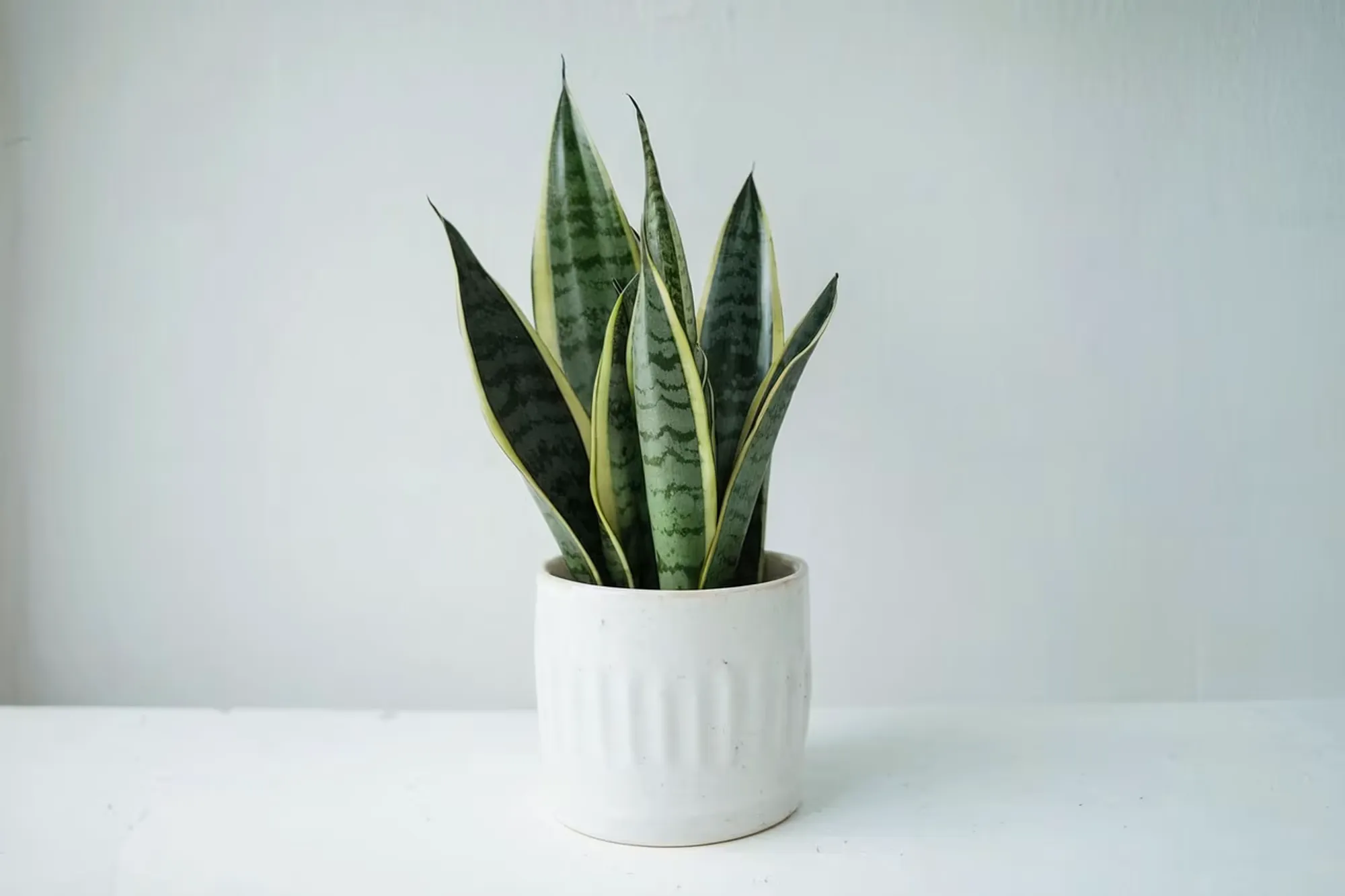Sansevieria trifasciata (Snake Plant): care, watering and benefits

🌿 Quick Summary:
- ☀️ Bright to medium light, highly adaptable.
- 💧 Water sparingly – let soil dry completely.
- 🌡️ Ideal temperature: 18–27 °C (65–80 °F).
- ✂️ No pruning needed, just leaf maintenance.
- 🪴 Repot every 2–3 years in well-draining soil.
🌿 About Sansevieria trifasciata
The Sansevieria trifasciata, also known as the snake plant or mother-in-law’s tongue, is a hardy tropical succulent native to West Africa.
Its upright, sword-shaped leaves with green stripes and yellow edges make it one of the most elegant and resilient houseplants.
Tough, sculptural, and almost impossible to kill, the snake plant thrives on neglect — perfect for busy people or low-light interiors.
🌿 Botanical profile
| Feature | Details |
|---|---|
| Scientific name | Sansevieria trifasciata |
| Common names | Snake plant, mother-in-law’s tongue |
| Family | Asparagaceae |
| Origin | West Africa (Nigeria, Congo) |
| Type | Succulent houseplant |
| Mature size | 30 cm to 1 m (12–40 in) |
| Light | Bright to medium light |
| Watering | Light, infrequent |
| Temperature | 18–27 °C (65–80 °F) |
| Humidity | Low to medium |
| Toxicity | Slightly toxic to pets |
☀️ Light and placement
The snake plant adapts to a wide range of light levels, from bright sunlight to partial shade.
It grows best in bright, indirect light, but tolerates low light exceptionally well.
💡 Tip: In darker rooms, reduce watering — less light means slower evaporation and water use.
Avoid direct sun behind glass, which can scorch the leaves.
💧 Watering and humidity
Sansevieria is a succulent and needs very little water.
Let the soil dry out completely between waterings.
- Summer: every 2–3 weeks.
- Winter: once every 4 weeks.
- Always empty any standing water in the saucer.
🚫 Overwatering = soft, mushy leaves and root rot.
💧 Underwatering = slightly wrinkled leaves (normal).
💡 Pro tip: Water around the edge of the pot rather than into the leaf center to prevent rot.
🌱 Soil and repotting
Ideal mix:
- 60% cactus or succulent soil
- 30% perlite or coarse sand
- 10% coconut fiber or fine bark
Use a well-draining, airy substrate to prevent waterlogging.
Repot every 2–3 years, ideally in spring, once roots begin to crowd the pot.
Choose a terracotta pot with drainage holes to promote airflow and moisture control.
🌾 Fertilizing
From March to September:
- Feed once a month with a diluted cactus or succulent fertilizer.
- Stop feeding during winter dormancy.
💡 Tip: Too much fertilizer causes brown spots and weak, floppy leaves.
✂️ Pruning and maintenance
Snake plants require minimal maintenance.
Remove damaged or yellow leaves at the base with clean scissors.
Dust the leaves occasionally with a damp cloth to keep them shiny and improve photosynthesis.
🪴 Design tip: Combine different Sansevieria varieties (Laurentii, Moonshine, Zeylanica) for a modern, architectural look.
🪴 Propagation
The snake plant is one of the easiest plants to propagate — through leaf cuttings or division.
How to propagate:
- Cut a mature leaf into 5–10 cm (2–4 in) pieces.
- Let them dry for 1–2 days to callus.
- Plant in dry, sandy soil.
- Lightly water after 2 weeks.
Roots will appear after 4–6 weeks.
Division of rhizomes is faster and preserves variegation patterns.
🍃 Soft or discolored leaves: what to do
| Symptom | Likely cause | Solution |
|---|---|---|
| Soft leaves | Overwatering | Let soil dry fully and improve drainage |
| Pale leaves | Lack of light | Move closer to a bright window |
| Brown tips | Dry air or excess fertilizer | Reduce feeding and increase humidity |
| Spotted leaves | Sunburn | Move to indirect light |
| Slow growth | Cold or nutrient deficiency | Keep above 15 °C (59 °F) and fertilize monthly |
🍀 Symbolism and benefits
The Sansevieria trifasciata is one of NASA’s top-rated air-purifying plants.
It absorbs formaldehyde, benzene, and xylene, improving indoor air quality.
Symbolically, it represents resilience, protection, and longevity — a perfect addition to bedrooms, offices, or living spaces.
🌙 Fun fact: It releases oxygen at night, making it ideal for bedrooms.
🛠️ Useful accessories
Keep your snake plant healthy with:
- 🌱 Cactus and succulent soil mix
- ☀️ LED grow light for low-light rooms
- 🪴 Terracotta pot set with drainage holes
(Affiliate links verified by Verdepedia.)
⚠️ Common mistakes
- Watering too often or leaving water in the saucer.
- Using compact, non-draining soil.
- Keeping in temperatures below 15 °C (59 °F).
- Overfertilizing (causes leaf burn).
🚨 Quick diagnostic guide
| Symptom | Cause |
|---|---|
| Soft leaves | Overwatering |
| Pale leaves | Low light |
| Brown edges | Excess fertilizer or dry air |
| Stunted growth | Cold or poor soil |
| Spots or burn marks | Too much direct sunlight |
❓ Frequently asked questions
Q: How often should I water my snake plant?
A: Every 2–3 weeks in summer, and once a month in winter. Always let the soil dry completely.
Q: Can I keep it in the bathroom?
A: Yes, as long as it gets some natural light and the room isn’t too humid.
Q: Is the snake plant pet-safe?
A: It’s slightly toxic if ingested, so keep out of reach of pets and small children.
Q: Does it really purify the air?
A: Yes — NASA’s study confirmed it absorbs harmful compounds and releases oxygen even at night.
